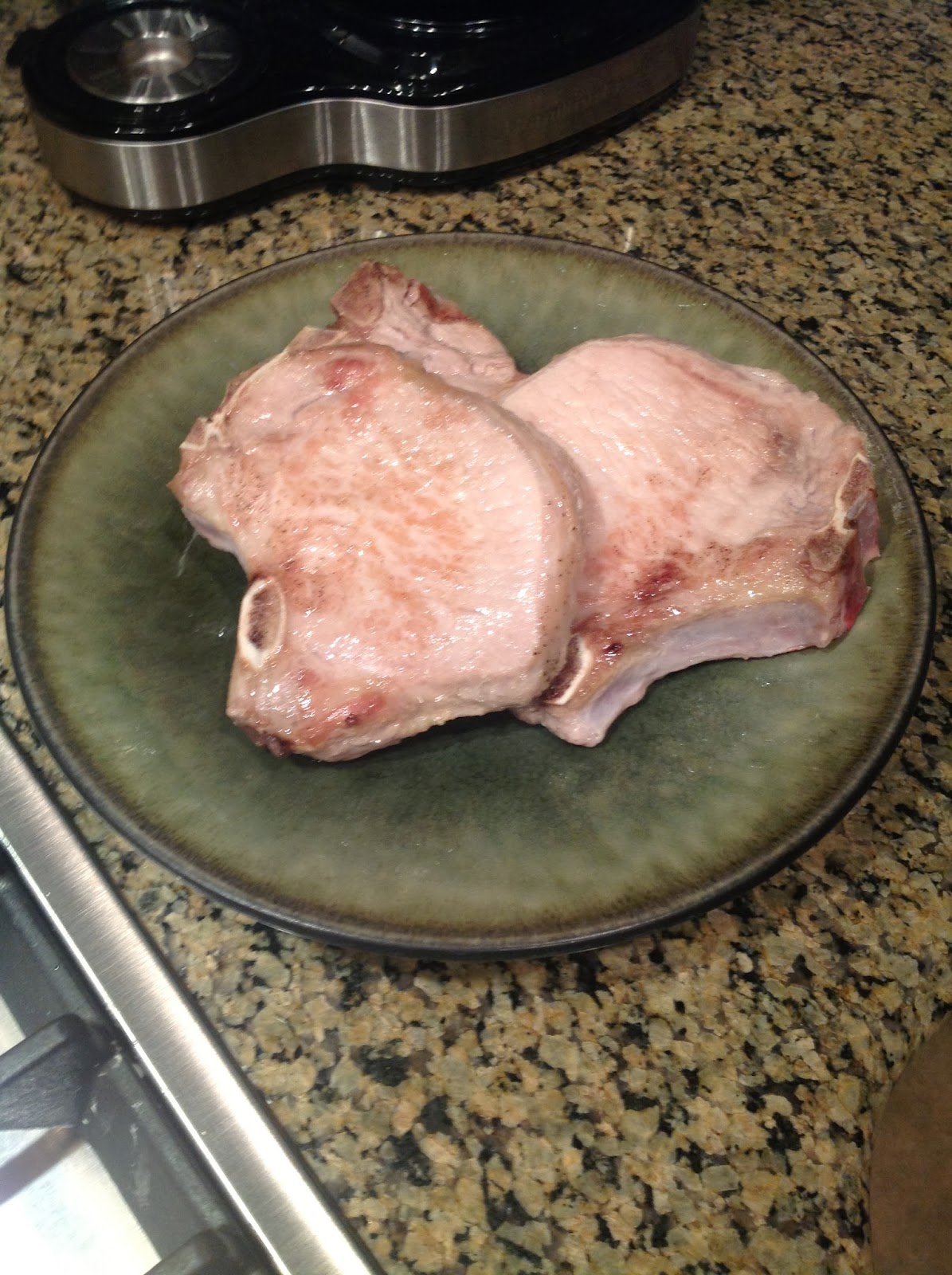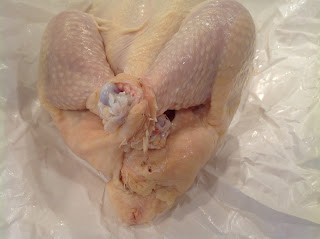Because a recipe ain't worth the vintage pot you cook it in if it has less than a four-word title. This recipe was a product of good ol' fashioned desperation followed by common-sense matching up of available ingredients bounded by the limits of time. Which is to say, my husband was hungry and rightfully expecting a meal of higher quality than scrambled eggs and lunch meat.
What makes this recipe great and probably just like every other sweet potato pork skillet is that as the pork chops bake in the oven they release all their lovely porky juices into the bottom of the pan where the sweet potatoes soak them up, so you get this messy pile of garlicy, porky, sweet potatoes to go with the chops.
Sweet Potato Pork Chop Skillet
4 pork chops (bone in or boneless is your choice)
3-4 medium sweet potatoes, peeled and shredded
3 TBSP unrefined organic coconut oil (or whatever cooking oil you have on hand)
1 1/2 tsp granulated garlic
1 tsp salt
1/2 tsp ground pepper
Preheat the oven to 350F. Heat an oven-safe skillet on medium-high heat, an add 1 TBSP of coconut oil. Salt and pepper the pork chops on both sides. Just before the coconut oil (or other cooking oil) has reached its smoke point, add the pork chops to sear & brown, approximately 90 seconds per side, depending on thickness. To avoid moisture loss in the pork chops do not crowd during the browning, and brown in two batches, if necessary. Remove pork chops from the pan and set aside. Add 2 TBSP coconut oil, and the shredded sweet potatoes. Season with garlic powder, salt, and pepper and start to brown. When potatoes start to reduce and skillet edges start to crisp, nestle all pork chops back into the sweet potatoes. Place into the oven for 30 minutes.
The pictures were an "oh yeah" sort of after thought, so my stovetop wasn't clean when I started cooking, and the unfortunate effects of the lighting don't often result in very appealing pictures. So, I'm going to do what I do best: steal from the internet. I'll mix in some of my pictures, too, just to keep things real.
First, we need to gather our tools together, so for this recipe you'll want a heavy, well-seasoned cast iron skillet. Don't have a skillet? Make sure whatever you're using is oven safe, because this is a one-pan wonder of a recipe.
You'll want a tongs, for the handling of the pork chops.
A box grater for the shredding of sweet potatoes.
And, a spatula for the flipping of sweet potatoes.
Next, we want our ingredients. For the purposes of smooth process, start with the sweet potatoes. Collect 3-4 medium sized sweet potatoes if you want lots of potatoes to go with your meat. 2-3 potatoes if you want less. When choosing remember that sweet potatoes shrink in the cooking process, so what looks like a Krakatoa-sized pile of shredded potatoes will likely cook down to a modest hill. If you've got a food processor to shred the potatoes in then bully for you. The rest of us have to use a regular box grater. This is probably the most work you'll end up exerting in this whole recipe, so....GO!
Locate our fancy-pants coconut oil and measure out 1 TBSP. I use this brand, mostly because it came in a paint-can sized container at Costco, but this recipe will work with olive oil or other seed oils of your preference. I wouldn't use butter for this because the milk solids will scorch and send nasty scorched milk solid smells throughout the food.
Now we can start heating our skillet up with the oil. Heat this skillet until the oil is almost or just at the smoke point. We want to be able to effectively sear and brown the pork chops.
Ignore, for the present, that I clearly used more than 1 TBSP here because, well, I was eye-balling things and not being very precise. The consequence was that my product came out oilier than necessary or, frankly, desirable.
While the skillet is heating, salt and pepper your chops.
I use bone-in chops because they are less expensive, and have a little more fat that renders into the sweet potatoes nicely. You can use whatever you want, but what you cannot do is crowd the chops during the browning process. If your chops are large and you can't have 2-inches or more between chops than brown your meat in two batches. I had four large chops, and I had to do a 3:1 round.
See? Any closer and the meat would start to steam and juice out, which we don't want it to do yet. Use your tongs to turn the chops, more for safety reasons than for any sort of high-quality cooking technique. Your Adventure Cooker has learned through bitter experience that flipping chops browning in hot oil using a spatula can cause an unexpected impact blast radius of aforementioned hot oil that can land on hands and fingers. So, save your epithelials the trouble of excessive regeneration and use a tongs.
One more note about browning the chops, my chops were close to 1.5 inches thick, so I browned for 90 seconds per side. Obviously, thinner chops can be done in less time. Once the chops are browned, set aside. Hopefully the skillet will have lovely brown bits of business on the bottom and will be hot enough to be smoking a little bit.
Add the remaining 2 TBSP of coconut oil.
Yes, yes. I know. WAAAAAY too much oil, but again, I was eyeballing things. Also, I may or may not have been on my second glass of wine by this time. Anyway, add the sweet potatoes you spent time, sweat, and possibly a little knuckle skin getting shredded.
Locate your seasonings. It's easy, like 1-2-3 easy.
Season your sweet potatoes with 1 1/2 tsp of garlic powder (more if you're fond of garlic), 1 tsp of salt, and 1/2 tsp of black pepper. This is the part where paying attention is really helpful. Because of the higher heat, the oil, and the naturally occurring sugars in the sweet potatoes, it is imperative to keep an eye on the browning process. Sweet potatoes go from lovely toast colored to BURNED BLACKER THAN A TAR PIT in seconds. This knowledge also comes to you from the Adventure Cooker Historical Notes of Learning Via Consequences. We are not cooking the sweet potatoes 100% of the way, but we are looking to get a browning started, so flip, turn, and stir the potatoes until they start reducing down. Next, bury your pork chops back into the sweet potatoes, and dump any juices in as well.
Pop this whole mess into a 350F degree oven for 25-30 minutes, or until the sweet potatoes start getting brown and crispy along the edges. Cast Iron skillets are marvelous for being easy to mentally register that they will be hot, so using a pot holder to move the skillet around isn't that far of a stretch of mental resources. If you are using an oven-safe teflon skillet or similar, REMEMBER to use a pot holder to move the skillet out of the oven. This public service announcement is brought to you by yet another one of the Adventure Cooker's bonehead blunders.
Off the subject of how many times your friendly Adventure Cooker Cook has injured herself in the kitchen, and onto how marvelous this meal smells when baking. It smells like home. It smells like comfort. It smells like nutrition made easy. And, it smells REALLY good.
This is another recipe that reheats well, but does not freeze and thaw nicely. Enjoy!


























































